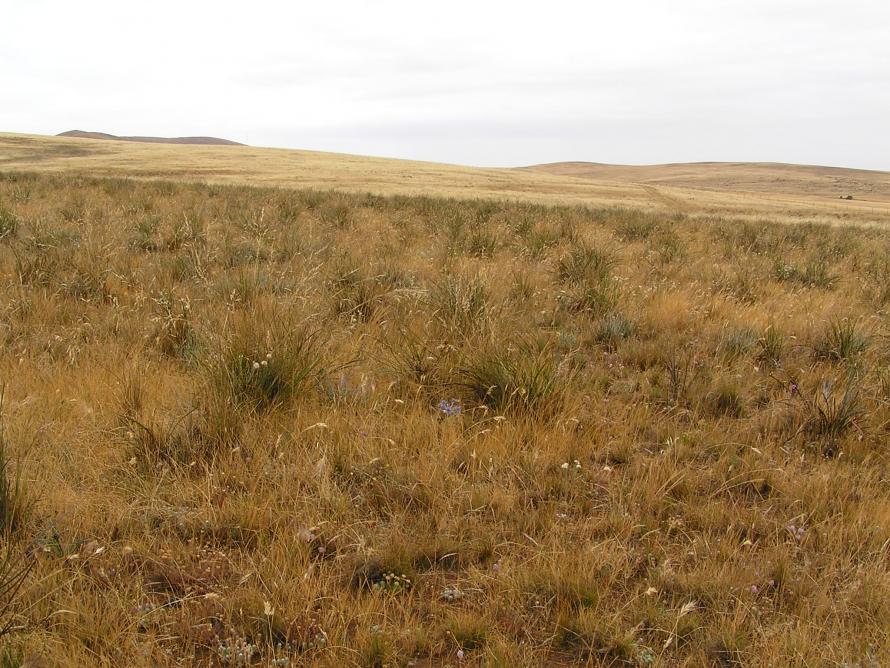
The terrain of the park is hilly with ephemeral watercourses and rock outcropping on the ridges. Native vegetation in the park comprises tussock grassland dominated by Hard Mat-rush (Lomandra multiflora ssp dura) over Bunch Wire-grass (Aristida behriana). Various spear (Stipa spp) and wallaby (Danthonia spp) grasses are co-dominant throughout. Due to the high proportion of herbaceous species, the appearance of the grassland changes markedly with the seasons. Vegetation on the northern and western slopes is very patchy. In places the structure is relatively open, with gaps between perennial grass and Lomandra tussocks occupied by a variety of seasonal herbs and soil that is bare or covered with a moss and lichen crust. Elsewhere the vegetation may be much denser, with alien species such as Wild Oats (Avena barbata) occupying the space between native grass tussocks and fewer native herbs. The condition of the vegetation is very variable due to past use for grazing with alien species becoming dominant near dams and on hill tops.
Mokota Conservation Park is located 5 km east of the township of Mount Bryan in the Clare Valley.
Interpretive signage, lookout, walking trails
National Parks South Australia (+61 8) 8892 3025
The Ngadjuri people occupied land in the North Mount Lofty Ranges, including the park, which was probably used for hunting or foraging. They may have burnt the grasslands from time to time as early settlers reported frequent fires in grasslands during the heat of summer. The area was described by the first surveyor in 1860 as good pastoral land and soon became freehold land that was grazed from the 1860’s until acquisition for conservation in 1999. The park was never cultivated and the previous landowner indicated it was grazed at a rate of approximately one lambing ewe per hectare between May and September each year. Lack of cultivation, consistently low stocking rate and minimal application of fertiliser, along with the yearly removal of stock at the start of spring are believed to be responsible for the high biodiversity values of the native grassland.
Three nationally threatened species occur within the park, the Flinders Worm Lizard (Aprasia pseudopulchella), Small Scurf-pea (Cullen parvum) and Trailing Hop-bush (Dodonaea procumbens). The rare white spotted skipper butterfly listed as vulnerable also occurs.
In autumn of 1996, the northern and western slopes of the park up to an altitude of about 650 metres were burnt. Vegetation monitoring. Weed control.
Park may be closed on days of extreme fire danger.
No camping or campfires
150 flora species
Western Grey Kangaroos, Red Kangaroo, Fox, Rabbit, Hare, Bearded Dragon, Bluetongue Lizard, Bougainville's Skink, Dwarf Skink, Flinders Worm Lizard, Shingleback, Brown Snake, Little Froglet, Australian Magpie, Brown Songlark, Skylark, Richards Pipit, Crested Pigeon, Feral Pigeon, Elegant Parrot, Galah, Willie Wagtail, Yellow-rumped Thornbill, Emu, Noisy Miner, Stubble Quail, Little Button-quail,Welcome Swallow, Fairy Martin, Wedge-tailed Eagle, Nankeen Kestrel, Australian Hobby, Brown Falcon, Black Falcon, Australian Raven, Magpie Lark, White-faced Heron, Zebra Finch, Common Starling, House Sparrow, Caper White Butterfly, Common Grass Blue Butterfly, Lesser Wanderer Butterfly, Meadow Argus Butterfly, Painted Lady Butterfly, Small Copper Butterfly, White Spotted Skipper